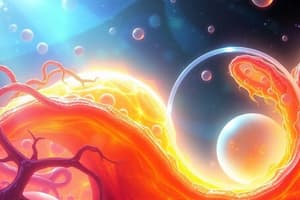Podcast
Questions and Answers
What is the primary difference between asexual and sexual reproduction?
What is the primary difference between asexual and sexual reproduction?
- Asexual reproduction only involves male gametes.
- Sexual reproduction produces offspring through splitting.
- Sexual reproduction involves the fusion of gametes. (correct)
- Asexual reproduction requires two parents.
Which statement best describes gametogenesis?
Which statement best describes gametogenesis?
- It involves the production of diploid gametes. (correct)
- It includes the reduction of chromosomes to haploid sets.
- It occurs only in female organisms.
- It takes place only in the somatic cells of the organism.
In which type of asexual reproduction does an organism produce a small bud that eventually detaches?
In which type of asexual reproduction does an organism produce a small bud that eventually detaches?
- Budding (correct)
- Fragmentation
- Binary fission
- Splitting
What is the result of the fusion of a sperm and an ovum during sexual reproduction?
What is the result of the fusion of a sperm and an ovum during sexual reproduction?
Which type of reproduction involves fragmentation to produce multiple offspring?
Which type of reproduction involves fragmentation to produce multiple offspring?
What is the primary process occurring in the ovaries of female cats?
What is the primary process occurring in the ovaries of female cats?
What is the outcome of the maturation phase in spermatogenesis?
What is the outcome of the maturation phase in spermatogenesis?
Which phase of spermatogenesis involves mitotic divisions?
Which phase of spermatogenesis involves mitotic divisions?
What type of sperm shape is associated with chordates such as fishes?
What type of sperm shape is associated with chordates such as fishes?
Which process describes the transformation of spermatids into spermatozoa?
Which process describes the transformation of spermatids into spermatozoa?
Flashcards
Embryology
Embryology
The study of early development of living organisms.
Asexual Reproduction
Asexual Reproduction
Reproduction needing only one parent, with the organism splitting, budding, or fragmenting to form new individuals.
Sexual Reproduction
Sexual Reproduction
Reproduction involving the fusion of male (sperm) and female (ovum) gametes to form a zygote.
Gametogenesis
Gametogenesis
Signup and view all the flashcards
Spermatogenesis
Spermatogenesis
Signup and view all the flashcards
Oogenesis
Oogenesis
Signup and view all the flashcards
Spermatogenesis
Spermatogenesis
Signup and view all the flashcards
Spermatids
Spermatids
Signup and view all the flashcards
Multiplication Phase (Spermatogenesis)
Multiplication Phase (Spermatogenesis)
Signup and view all the flashcards
Meiosis
Meiosis
Signup and view all the flashcards
Study Notes
Embryology
- Embryology is the study of early living organism development
- All animals and plants can reproduce to ensure survival of their kind
Reproduction
- Asexual reproduction
- One parent splits, buds, or fragments to create two or more new organisms
- Examples include: splitting (Paramecium), budding (Hydra), fragmentation (yeast)
- Sexual reproduction
- Two gametes (sperm and egg) fuse to form a zygote
- Male gamete (sperm) fuses with female gamete (egg)
- The zygote develops into an embryo via embryonic development stages
Asexual Reproduction: Types
- Splitting: The organism splits into two individuals (e.g., Paramecium)
- Budding: The organism produces a small bud that grows on the parent's body and then detaches (e.g., Hydra)
- Fragmentation: The organism fragments into pieces, each of which develops into a new organism (e.g., yeast)
Sexual Reproduction
- Fusion of male and female gametes (sperm and ovum) to form a zygote
- Sperm's chromosomes (n) join with ovum's chromosomes (n) forming the zygote's chromosomes (2n)
- Zygote undergoes embryonic development, dividing into many somatic cells (2n) that form the embryo
Gametogenesis
- Production of gametes (sperm and egg) by parents
- Reduction in chromosome number from diploid (2n) to haploid (n) in the resulting gametes
- Gametogenesis in testis (spermatogenesis): a series of steps
- The steps: Multiplication, Growth, and Maturation phases
- Results in the production of four sperms from one primary spermatocyte
- Gametogenesis in ovary (oogenesis): a process
- The steps: Multiplication, Growth, and Maturation phases
- Results in one ovum (egg) from one primary oocyte
Spermatozoon
- Structure: Head, midpiece (body), principal piece, and tail
- Different types of shapes (spherical, Y-shaped, spiral, spoon-shaped) exist depending on the organism, e.g., Chordates, Amphibia, Reptiles, and Mammals.
Studying That Suits You
Use AI to generate personalized quizzes and flashcards to suit your learning preferences.



